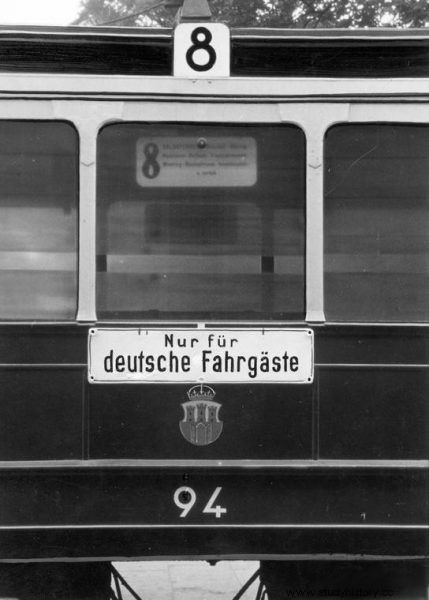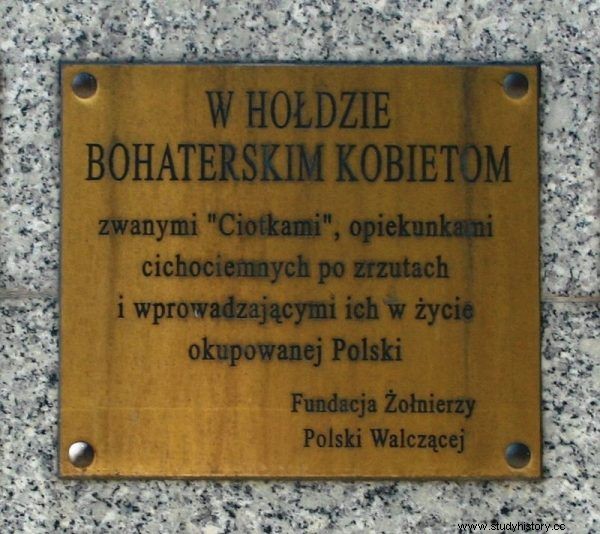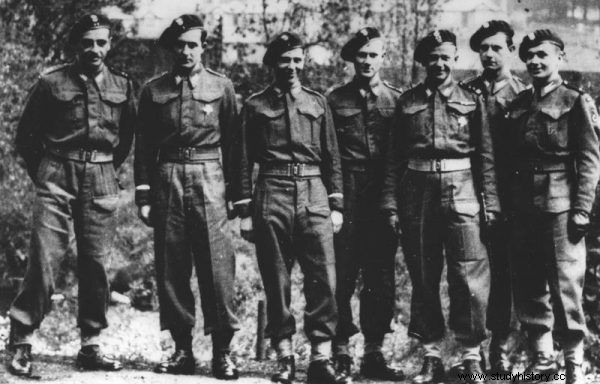After months of learning the military trade and exhausting exercises, they were dropped over occupied Poland. Before they could act, however, they had to learn one more, perhaps the most important thing - how to survive and not get caught.
As they walked down the street, they looked around carefully. They tried to be as natural as possible. They did not want to draw attention to themselves, but at the same time they could not get rid of the curiosity that accompanied them. After more than two years, they returned to Poland, in Warsaw. But that was different Poland, different Warsaw.
They saw it at every turn. Stanisław Jankowski "Agaton", a cichociemny who would soon take the position of the head of the unit producing false documents for the intelligence of the Home Army Headquarters, wrote years later in his memoirs that people "seemed to me tired, as if in a hurry somewhere". On the road, a small number of him wondered
passenger cars, but [there were] a lot of new vehicles for me:bicycle rickshaws. Old Warsaw trams, strangely unevenly filled. Crowded in the part intended for Poles and almost empty, transparent in the part separated by a sign:Nur fur Deutsche.

Trams with designated places only for the Germans were a novelty for the quiet people transported to the country (in the photo:a tram in Krakow).
Such observations were made by almost all the Cichociemni who came to Warsaw shortly after the landing. What they had learned in Great Britain during courses on everyday life in occupied Poland, they had to quickly verify. For on whether they would be able to put theory into practice depended not only on the success of their mission, but also whether they would survive for more than a few days.
Tea from my uncle
To increase the commandos' chances of surviving those first moments when they were most exposed to danger, the underground introduced a number of procedures. They were implemented immediately after landing.
First of all, the team serving the landing site was to transport the Cichociemni as quickly as possible to the railway station, from where the train took them straight to Warsaw. During the trip, they were accompanied by a guardian, who was to ensure that ... they did not draw attention to themselves. Not knowing the reality of the occupation from the autopsies, the soldiers could, after all, attract the eyes of a gendarme or an accidental spy (and there was no lack of them then) with a careless gesture or unusual behavior.
After arriving in Warsaw - in pairs, because they were always "thrown" in several - they headed towards the so-called "Hot place", the address of which was given to them before they even boarded the plane. Ludwik Witkowski "Kosa" mentioned that:
the point was to be entered carefully. I was supposed to go first, and if I didn't come back after two or three minutes, Witek was supposed to stop watching the shop window and follow in my footsteps.
Each subsequent duo did the same. This procedure had a serious drawback - if the Germans had arranged a "cauldron" in the apartment, cichociemni would have dropped by it one by one . However, they had to take a risk and walk up the stairs and knock on the right door. To the question:"Lord to whom?" they answered according to the agreed code, for example:"I'm bringing tea from uncle Władysław."
When everyone got together, the anticipation began. The soldiers eagerly looked for and listened to the envoys who were to take them under their professional care. Before that could happen, however, they had to be dealt with here and now. Witkowski noted that their hostess "apologized for the modest reception, gave us hot sausages, tea and a glass of vodka".
Agaton and his friends received a more abundant breakfast. They were offered "English tea, dried sausage, homemade preserves and a colorful story about everyday life in Warsaw . Densely interwoven with news from newspapers, the latest BBC news and black market news. " Hearing these stories, the men finally fell asleep. Fatigue and emotions did their job. From this half-dream they were awakened by the appearance of the mysterious guardians.
Learning to walk
"I am aunt Antosia" - this sentence has been heard by many Cichociemni. There is an extraordinary figure behind him. Inconspicuous and at the same time the last lecturer for these well-trained intelligence and diversion specialists, a woman.
Michalina Wysznewska, "Ciocia Antosia", was the head of a special unit taking care of the Cichociemni. Her employees were commonly referred to as "aunts". Jankowski wrote about them that “there were different organizational 'aunts', young and old, cheerful and concerned. But all of them brave and wholeheartedly devoted to their “birds” ”. The most remarkable of them was precisely Wieszwska. As Agaton reported in his memoirs:
Corpulent, just right for an aunt - reported Jankowski. - She liked to listen to "indecent" jokes, drink strong coffee and even in the worst oppressions, she did not lose her cheerfulness. At the bottom of her abyssal bag - stuffed with women's trinkets - she carried newspapers, drop guns, revolvers, and secret messages .

In occupied Poland, the so-called Cichociemni aunt.
Even when she stopped caring for this or that, she still remembered about them. When she met Jankowski during the Warsaw Uprising, she decided to get him decent shoes. She died torn by a bullet while saving another bird.
But that was yet to come. For now, day after day, she was looking after the next drops. From the "hot place" she took them to the "cold place". Everyone got their own, where a room was rented for him from the initiated family. The hosts did not know who their tenant was. Of course, they were aware that it was someone associated with the underground, but who exactly or what their real name is - they did not have to, or even should not know. Besides, they hosted the Cichociemni mostly only for a short time, necessary to learn how to function in the reality of the occupation.
What exactly did the newcomers learn? Among other things, how to blend in with the crowd thanks to clothes, how to check if you have a "tail", what is a round-up, how to get away from it, what behaviors to avoid on the street ... But even after they had fully grasped the theory, they still had to master the practice . And that took weeks of walking, walking, and walking again. At the same time, unable to actively participate in the work of the underground, the commandos trained patience and controlling emotions.
Felicjan Majorkiewicz "Iron" told how he first went out onto the street with "Aunt Antosia". “Throughout our march I was quite calm, but I felt uncomfortable as we passed and almost rubbed against SS men with 'sprayers'. Then (...), in turn, she pressed my hand harder to her, and her gentle smile restored me completely at peace ".

During their training in Great Britain, Cichociemni learned theories about what life in occupied Poland looks like.
In the new quarters, she visited him every day - and so did the others. She checked how they felt, how much they understood from what they saw, whether they were afraid of something. How quickly they managed to overcome their fear depended on when they would be assigned to organizational work. She went on shorter and longer walks with them. They visited shops, cafes, bars and markets. During these journeys, she observed their behavior and corrected any that might have betrayed them.
After all, she had to get documents for each of them - better than the ones they jumped with. These papers - as well as clothes without English patches - were the bare minimum necessary for survival. One mistake could have cost many lives.
How are we?
There was one more issue for which the "aunts" were responsible - namely the meetings of the Cichociemni with their families. Conspiratorial security considerations generally forbade such "trysts". It not only increased the chances of a good camouflage of the jumper himself, but also removed the danger from his relatives. In the event of a chase after "Agaton" or "Kosa", their families could have been used by the Germans as a bargaining chip.
But the organizational rules often ended with theory. In fact, the need to see parents, wife or children proved to be stronger than what had been inculcated into the minds of the quiet and the dark for months. And usually the "aunts" broke down. Thanks to this, Witkowski persuaded Wieszwska to let him see her brother, and Jankowski met his mother-in-law and his wife.
What did these "visions" look like? As a rule, they were necessarily short and rather numb ... There was no question of throwing yourself into your arms. At most, both sides could greet each other with a nod or a handshake. Excessive enthusiasm in the street drew attention - and they didn't want to.
So they stood at a stop or at a gate on the street and chatted casually. About what's going on at home. Like mom, what about the dog, are the neighbors alive. These first meetings after returning home were extremely emotional for them. So much so that they would remember the smallest details for years. Jankowski later wrote in his memoirs that his wife was wearing "a camel's wool jacket made from the lining of my coat, a small brown hat and a well-known large leather bag, which we ordered together from a saddler".
After seeing the family, they were usually ready to go. Equipped with the appropriate documents, and most importantly - understanding where they ended up, they received a long-awaited call. When they returned from it, they already knew where the "mountain" had assigned them. At this point, the quarantine was ending and the real work was beginning.
Bibliography:
- Jankowski S., Agaton. With a fake ausweis in real Warsaw, Bellona / National Cultural Center 2019.
- Kostuch T., Double loop , Ministry of National Defense 1988.
- Majorkiewicz F., We had the chance to survive , PAX Publishing Institute 1972.
- Witkowski H., Witkowski L., Kedywiacy , PAX Publishing Institute 1973.
